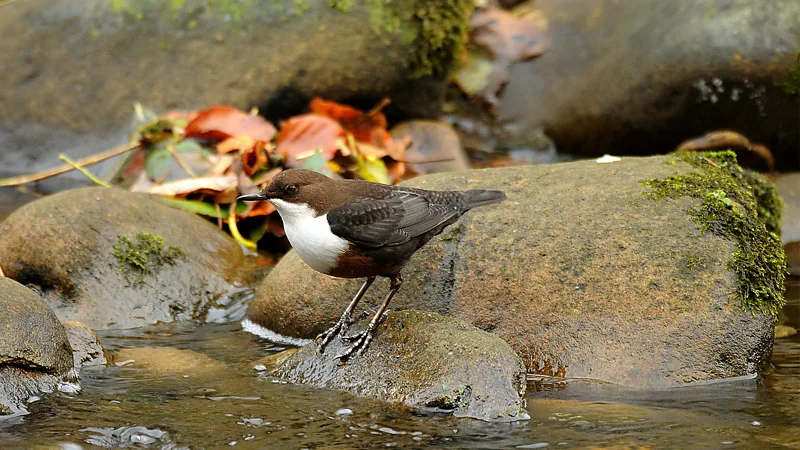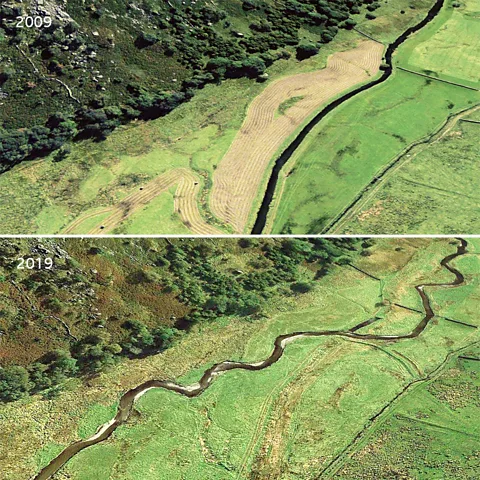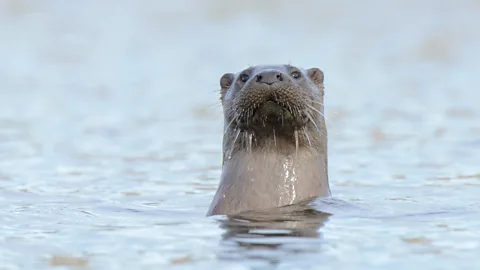News
Natural Gas Prices On The Rise To A 13 years High This Winter
September 11, 2021
September 19, 2024
For centuries meandering rivers have been straightened – but experts say restoring their natural bends and curves can prevent flooding and create healthy habitats for wildlife.
Swindale Beck, a stream in Cumbria, in the heart of the UK's Lake District, meanders through fields, farmland and valleys. However, not long ago, the river took a far more linear course.
A healthy river should be sinuous, free flowing and replete with wildlife. In Britain, however, 97% of rivers are fragmented by artificial barriers like weirs. Now, there is at least one artificial barrier for every 1.5km of stream in the country. And for centuries rivers have been slowly canalised – or artificially straightened – to stop water from flooding and spilling onto farmland and houses.
But removing a river's natural meanders has, in fact, achieved the opposite effect. Instead, it's disrupted the flow of rivers and degraded aquatic habitats, water quality and heightened flood risk. As the poor health of Europe's rivers and streams continues to make news – due to dwindling wildlife, sewage pollution and agricultural runoff – communities are turning towards natural solutions to restore their rivers.
 RSPB
RSPBSome rivers are being restored with natural flood management techniques (NFM), such as leaky woody dams, tree planting and beaver pens. One idea is to add wiggles back into rivers, streams and tributaries. Across the world, from the Netherlands, the US and the UK, rivers are slowly being re-wiggled, to return them to their natural course. And, in the UK, the rewards are starting to pay off, with fish, birds and invertebrates flocking back to rivers in Cumbria and West Sussex.
Two hundred years ago, Swindale Beck was straightened out to create more space for farmland. But since 2016, a project has been underway to undo this process and restore the river to its natural state. Led by the Royal Society for the Protection of Birds (RSPB) the goal is to create more diverse habitats, structures and morphology.
The ideal river is "very dynamic, messy and chaotic", says Glen Swainson, the RSPB's Site Manager at Wild Haweswater. "You want riffles where the water flows over stones and gravels, making bars and islands," he says. "When the river is more braided you have multiple channels across the floodplain that separate and rejoin each other."
After studying the valley to locate the original path carved out by the river, the charity enlisted a team of diggers to reshape and create new channels. The project was in conjunction with the Environment Agency, Natural England and the water company landowner (United Utilities) and cost over £200,000 ($260,000) to re-wiggle the 1km (0.6-mile) stretch.

First, they conducted a study of the area to map the original path of the river, before recruiting a team of diggers, who spent three months carving out this bendy path as closely as possible. Swindale Beck is now about 180m (590ft) longer than the canalised stream that had flowed through the valley for over two centuries.
According to Tom Hayek, a natural flood management specialist at the Wildfowl and Wetlands Trust (WWT), adding meanders into rivers has two draws – it alters both the speed and the volume of water. Firstly, it decreases what's known as flow conveyance. "This is the amount of water that a river can move downstream," says Hayek. "When the length of the river is increased, you spread water over a wider area. "This allows more water to sit up in the headwaters, which is where re-wiggling usually happens, rather than in a pinch in towns downstream."
The second impact is on speed. Put simply, the more structure you add to the morphology of a river, the slower the water will move down it. If it's straight, water will "fly" through, says Hayek. "The speed and the volume that builds up as tributaries feed in means at some point in the river there's no capacity to hold the water and flooding occurs," he adds.
In the past, it was common to dredge rivers to create more capacity to cope with floods but, says Hayek, this does little to stop the root of the problem. Instead experts are moving towards natural flood management techniques, to restore rivers to their full floodplain.
Devastating floods spread across Europe
Rivers are in the spotlight in Europe this week after catastrophic floods left a trail of devastation across Austria, Poland, the Czech Republic and Romania. More than 20 people have died and thousands of people have been evacuated, including the entire town of Nysa in Poland – more than 40,000 people.
While restoring rivers could help reduce the impact of smaller floods, experts say it wouldn't be enough to prevent the kinds of extreme floods seen in Central Europe in the past few days, as the masses of water are too large to be absorbed.
Scientists warn that climate change is leading to increased rainfall and more floods in some areas of Europe as the warmer air holds more moisture. Restoring rivers to their natural state, removing dams and managing floodplains could help us cope with that higher flood risk, according to experts, and various restoration projects are planned or underway across Europe as part of this effort.
When the flow of water is slowed, it creates deeper pools for fish to congregate and rest. Areas of the river where finer gravel has accumulated are a perfect spawning habitat for salmon that would have swum past before, says Swainson.
After Swindale Beck was straightened the results were "mind blowing", says Annabel Rushton, the visitor experience manager at Wild Haweswater. "A lot of nature conservation is a long game. You plant a tree, you're not going to in your lifetime see that it reached its full potential. But within three months of that river being re-wiggled the salmon were spawning in that one kilometre stretch for the first time in over 150 years," she says.
Although the salmon was the poster boy of river restoration, they also noted an increase in trout and minnows congregating. Then, there were the knock-on-effects. Water-loving vegetation returned, providing cover for young fish to feed and hide.
Re-wiggling the Beck allowed the river to clean itself too, as artificially straightened rivers flow faster and pick up more sediment. This was a bonus for water companies, as before murky water was being carried downstream to the Haweswater Reservoir. Now, the curves encourage the river to deposit its sediment on the banks.
In Cumbria, there have been over 100 restoration projects as part of this programme, but Swainson warns that re-wiggling rivers is not a "one-size-fits-all" solution. It's difficult "to model the benefits of something that is inherently different every time you do it, because it's a different landscape, a different altitude or a different substrate," she says.
 Google Earth
Google EarthFor Swindale Beck, the population density of the area was very low, with only a few houses in the valley lying in the floodplain. If it was a different catchment, with multiple landowners on each bank, it might have been more complicated, he says.
However, the changing climate is intensifying the need for river restoration. Firstly, there's a change in weather patterns, says Hayek, with particularly wet summers. But also, the scale of rainfall events is changing. "Rather than a lot of normal rainfall events over winter and summer you get an absolute deluge, dropping 10 times what it historically would," adds Hayek.
More development and concrete surfaces heightens the risk of catastrophic floods. "Between straightened rivers, hard surfaces and climate change, we've created a perfect storm," he says. This has led to a push towards natural flood management techniques – ways to use natural materials and processes to store and slow the flow of water through a river catchment.
For example, leaky dams are branches or tree trunks that are placed into a river to create a natural obstruction. Water is held back on the banks, and released gradually over time. Other techniques include strips of vegetation, ponds and shallow scrapes and beaver pens. "It's a double whammy of benefits to stop water from ending up in people's living rooms," says Hayek.
 David Mower
David MowerThe Knepp Castle Estate lies to the south of Horsham, West Sussex, and is crossed by the river Adur. Once used for intensive farming, the estate was rewilded in 2001, and is now a model for various river restoration methods.
The river stretches for 32 km (20 miles), but the surrounding land was drained in the 1800s for fields, causing rivers to bypass floodplains and ending up in settlements instead. In 2001, an effort to restore the meanders of the river began, in collaboration with the Adur & Ouse River Trust and Environment Agency.
Similar to Swindale Beck, the idea was to slow the flow of the River Adur. "When it rains, water runs off the land really quickly. It hits the ditches and the streams and the rivers, and doesn't infiltrate," says Melanie Sanders, Knepp Estate's River Recovery Manager.
The project also involved a range of other natural flood management techniques, including removal of weirs and addition of woody debris. And by re-naturalising the channel they also created wetland habitat with scrapes and ponds within the floodplain. "These are really important for insects, such as dragonflies and amphibians, plus wading birds that come down and feed on those muddy margins as well," she says. "Since the restoration, we've seen more female bats, which suggests that the feeding ground is very good, because they're obviously roosting nearby."
CARBON COUNT
The emissions from travel it took to report this story were 0kg CO2. The digital emissions from this story are an estimated 1.2g to 3.6g CO2 per page view. Find out more about how we calculated this figure here.
Around 50 UK Biodiversity Action Plan priority species – those identified as being the most threatened and requiring conservation action – reside on the Knepp Estate. According to one study, those likely to benefit from the river restoration include the water vole, barbastelle bat, great crested newt, common eel and grass snake. Spot samples in 2017 showed a return of various invertebrate species, including beetles, worms, damselflies and mayflies.
After a series of climate change-intensified storms hit the UK in 2023, the WWT has called on the Government to increase the amount they spend on natural flood prevention by an extra £130m ($169m) per year to address the river crisis.
"We should be re-wiggling and working with natural processes," says Hayek. "What we need is we need to get these rivers back into their full floodplain."
BBC